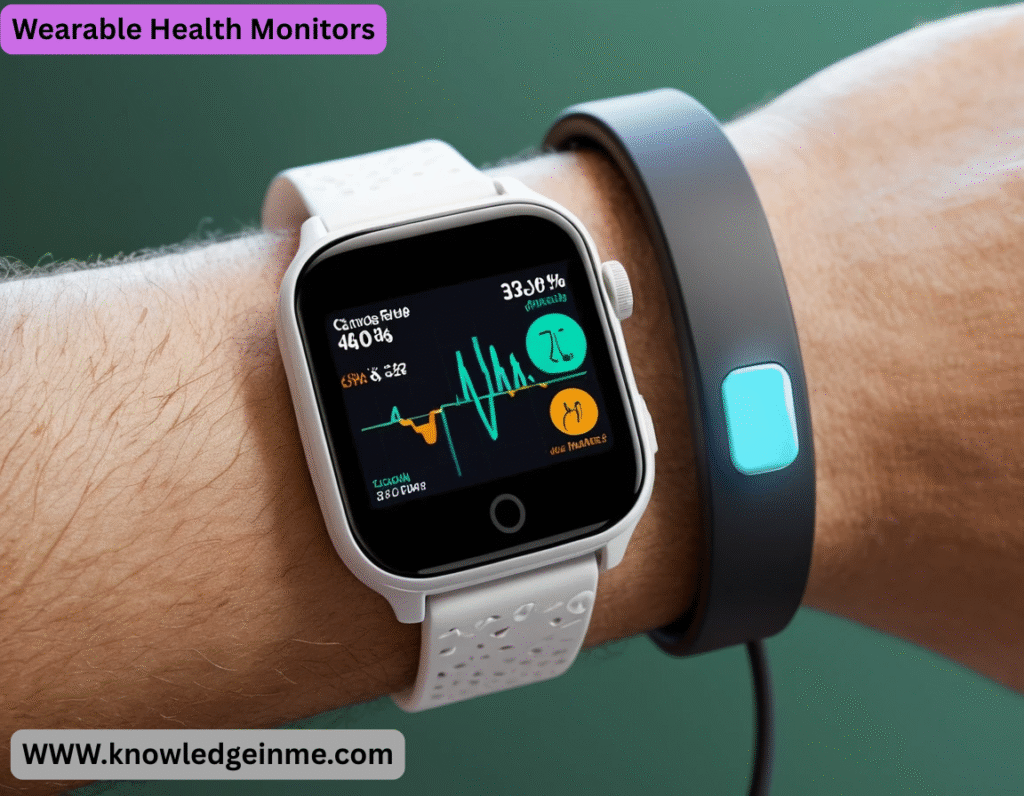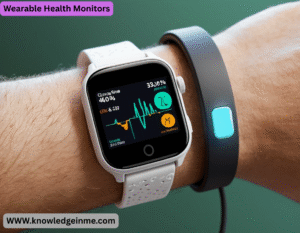Wearable Health Monitors Wearable health monitors are devices designed to track various health metrics in real-time, offering users insights into their physical activity, vital signs, and overall well-being. These devices have become increasingly popular due to advancements in sensor technology, data analytics, and consumer interest in personalized health.
Types of Wearable Health Monitors
- Fitness Trackers (e.g., Fitbit, Garmin)
- Track steps, distance, calories burned, and sleep patterns.
- Some include heart rate monitoring and SPO₂ (blood oxygen) sensors.
- Smartwatches (e.g., Apple Watch, Samsung Galaxy Watch)
- Monitor heart rate, ECG, blood oxygen, and sleep.
- Advanced models detect irregular heart rhythms (AFIB) and falls.
- Medical-Grade Wearables (e.g., Dexcom CGM, Zio Patch)
- FDA-approved for continuous glucose monitoring (CGM) or cardiac monitoring.
- Used by patients with chronic conditions like diabetes or heart disease.
- ECG & Blood Pressure Monitors (e.g., WITHINGS BPM Core, Omron Heart Guide)
- Provide medical-grade electrocardiogram (ECG) and blood pressure readings.
- Smart Clothing & Patches (e.g., HEXO skin, Bio Stamp)
- Embedded sensors in shirts or adhesive patches track muscle activity, respiration, and more.
Key Health Metrics Tracked
- Heart Rate (resting & active)
- Blood Oxygen (SPO₂)
- Sleep Quality (REM, deep sleep, interruptions)
- Physical Activity (steps, workouts, calories)
- ECG & Blood Pressure (in advanced models)
- Glucose Levels (for diabetics via CGMs)
Benefits of Wearable Health Monitors
- Early Detection – Alerts for abnormal heart rates, low oxygen, or poor sleep.
- Chronic Disease Management – Helps diabetics, hypertension, and cardiac patients.
- Fitness Optimization – Tracks workouts and recovery for athletes.
- Remote Patient Monitoring (RPM) – Doctors can monitor patients in real-time.
- Personalized Health Insights – AI-driven recommendations based on data trends.
Challenges & Considerations
- Accuracy – Some wearables may not be as precise as medical devices.
- Data Privacy – Health data security is a concern (HIPAA compliance for medical devices).
- Battery Life – Continuous monitoring can drain power quickly.
- User Compliance – People may stop wearing them over time.
Future Trends
- AI & Predictive Analytics – Early warnings for potential health issues.
- Non-Invasive Glucose Monitoring (without needles, still in development).
- Integration with Telemedicine – Seamless sharing of data with healthcare providers.
- Expanded Biometrics – Cortisol (stress hormone) monitoring, hydration levels.
Best Wearables in 2024
- Best Overall: Apple Watch Series 9 (ECG, SPO₂, fall detection)
- Best for Fitness: Garmin Forerunner 265 (advanced running metrics)
- Best for Diabetics: Dexcom G7 (real-time glucose monitoring)
Emerging Technologies in Wearable Health Monitors
- Wearables are evolving rapidly with cutting-edge innovations:
- Non-Invasive Blood Glucose Monitors (e.g., Abbott’s Lingo) – Future devices may track glucose without finger pricks (still under FDA review).
- Skin Sensors – Ultra-thin, flexible patches (like MC10’s Bio Stamp) monitor hydration, UV exposure, and muscle activity.
- Brainwave Headbands (e.g., Muse, DREEM) – Track sleep stages and stress via EEG.
- Smart Rings (e.g., OURA Ring, Ultrahuman) – Focus on sleep, temperature, and HRV in a discreet form.
- AI-Powered Coaching – Devices like Whoop analyze recovery and suggest optimal workout times.
How to Choose the Right Wearable
Consider these factors:
- Health Goals
- General fitness: Fitbit, Garmin.
- Heart health: Apple Watch (ECG), Withings Scan Watch.
- Diabetes: Dexcom G7 (CGM), Free Style Libre 3.
- Sleep optimization: OURA Ring, Fitbit Sense 2.
Accuracy
- Look for FDA-cleared features (e.g., ECG, blood pressure).
- Clinical studies (e.g., Apple Watch’s atrial fibrillation detection).
Battery Life
- Smartwatches: 1–2 days (Apple Watch), up to 2 weeks (Garmin).
- Specialized devices: 7+ days (OURA Ring, CGMs).
Ecosystem
- iOS users: Apple Watch integrates seamlessly.
- Android users: Samsung Galaxy Watch or Google Pixel Watch.
Cost
- Budget: Fitbit Charge 6 (~$150).
- Premium: Apple Watch Ultra 2 (~$800).
Wearables in Professional Healthcare
Hospitals & Clinics Use wearables for:
- Remote patient monitoring (e.g., cardiac patients wearing Zio patches).
- Post-surgery recovery tracking (e.g., smart bandages monitoring wounds).
- Clinical Trials – Wearables provide real-world data (RWD) for drug development.
- Mental Health – Devices like Empatica detect anxiety/seizures via skin conductance.
Privacy & Data Security Concerns
- Who owns your data? Companies may sell anonymized health data to third parties.
- HIPAA Compliance – Most consumer wearables aren’t HIPAA-covered (medical-grade ones are).
Tips to Protect Data:
- Disable unnecessary sharing (e.g., social media integrations).
- Use strong passwords and 2FA for health apps.
The Future: What’s Next
- Multimodal Sensors – Combining sweat analysis (lactate, electrolytes) with traditional metrics.
- Implantables – Like Abbott’s Confirm Rx (implantable cardiac monitor).
- AR/VR Integration – Smart glasses (e.g., Meta Ray-Bans) could monitor health via voice/eye tracking.
- Gut Health Wearables – Ingestible sensors (e.g., Pill Cam) tracking digestive health.
DIY & Open-Source Wearables
For tech enthusiasts:
- Open APS – A DIY closed-loop insulin delivery system.
- Biohacking Communities – Experiment with EEG wearables (Muse) or continuous temperature tracking.
Are Wearables Worth It
Pros:
- Empowerment through real-time health data.
- Early detection of serious conditions (e.g., AFIB, sleep apnea).
Cons:
- “Analysis paralysis” – Over-monitoring can cause anxiety.
- Not a substitute for medical diagnosis.
Final Recommendations by Use Case
Goal Best Wearable Choices
All-in-one health Apple Watch Series 9, Samsung Galaxy Watch 6
Serious athletes Garmin Fenix 7, Whoop 4.0
Sleep tracking OURA Ring (Gen 3), WITHINGS Sleep Analyzer
Diabetes Dexcom G7 (CGM), Free Style Libre 3
Budget-friendly Fitbit Charge 6, Xiaomi Band 8
Niche Wearables: Beyond Fitness & Medical
Women’s Health
- Temp drop – Wearable basal body temperature sensor for fertility tracking.
- ELVIE Pump – Smart breast pump with milk volume tracking.
Aging & Elderly Care
- Lively Wearable2 – Fall detection with 24/7 emergency response.
- Care Predict – AI-powered wearable detects early signs of illness (e.g., reduced activity = UTI risk).
- Samsung Galaxy Watch’s “Fall Detection” – Auto-calls emergency contacts if a hard fall is detected.
Mental Health & Stress
- Apollo Neuro – Wristband that uses vibrations to reduce stress via “touch therapy.”
- Spire Stone – Clip-on tracker monitors breathing patterns for anxiety detection.
- Muse Headband – Real-time EEG feedback for meditation training.
Technical Deep Dive: How Do These Sensors Work
Optical Heart Rate Sensors (PPG)
- How it works: Shoots green/red LED light into skin; measures blood flow changes.
- Limitations: Less accurate during high-intensity exercise or on darker skin tones.
ECG (Electrocardiogram)
- How it works: Measures electrical signals from the heart (e.g., Apple Watch’s electrodes).
- Medical vs. consumer-grade: Single-lead (wearables) vs. 12-lead (hospital ECG).
Bioimpedance Sensors
- Used for: Body fat %, hydration levels (e.g., Samsung Bio Active Sensor).
- Controversy: Highly variable accuracy compared to DEXA scans.
Blood Oxygen (SPO₂)
- Pulse Oximetry Principle: Infrared light detects oxygenated vs. deoxygenated blood.
- COVID-19 impact: Spurred adoption for detecting “silent hypoxia.”
The Dark Side of Wearables: Criticisms & Controversies
“Over diagnosis” & Health Anxiety
- Example: Detecting harmless heart arrhythmias (e.g., PVCs) that lead to unnecessary doctor visits.
- Study: JAMA (2020) found 11% of Apple Watch AFib alerts were false positives.
Corporate Data Exploitation
- Who sells your data? Fitbit (owned by Google) shares aggregated data with advertisers.
- Lawsuit: Class-action against Fitbit in 2021 for inaccurate heart rate tracking.
Racial & Gender Bias in Sensors
- Problem: PPG sensors less accurate on darker skin (Stanford 2020 study).
- Solution: Companies like Apple now test on diverse skin tones.
Environmental Impact
- E-waste: 40M+ smartwatches discarded annually (Greenpeace report).
Sustainable options:
- Garmin’s solar-powered watches (e.g., Instinct 2 Solar).
- Fair phone’s repairable wearables (future concept).
Wearables in Extreme Environments
Space Travel
- NASA’s Artemis Program: Testing Whoop bands to monitor astronaut fatigue.
- HEXO skin Smart Shirts: Used on ISS to track respiration in microgravity.
Military & Tactical Use
- Q-Warrior AR Headset: Tracks soldiers’ vitals + overlays battlefield data.
- Polar M430: Adopted by militaries for endurance training optimization.
Deep-Sea Diving
- Garmin Descent Mk3: Tracks blood oxygen saturation during decompression.
DIY Biohacking with Wearables
Quantified Self Movement
Tools:
- Continuous Glucose Monitors (CGMs) for non-diabetics (e.g., Levels, Nutri sense).
- OURA Ring + Chat GPT – AI analyzes sleep data for personalized advice.
- Controversy: Biohackers using Ozempic off-label for weight loss (tracked via CGMs).






